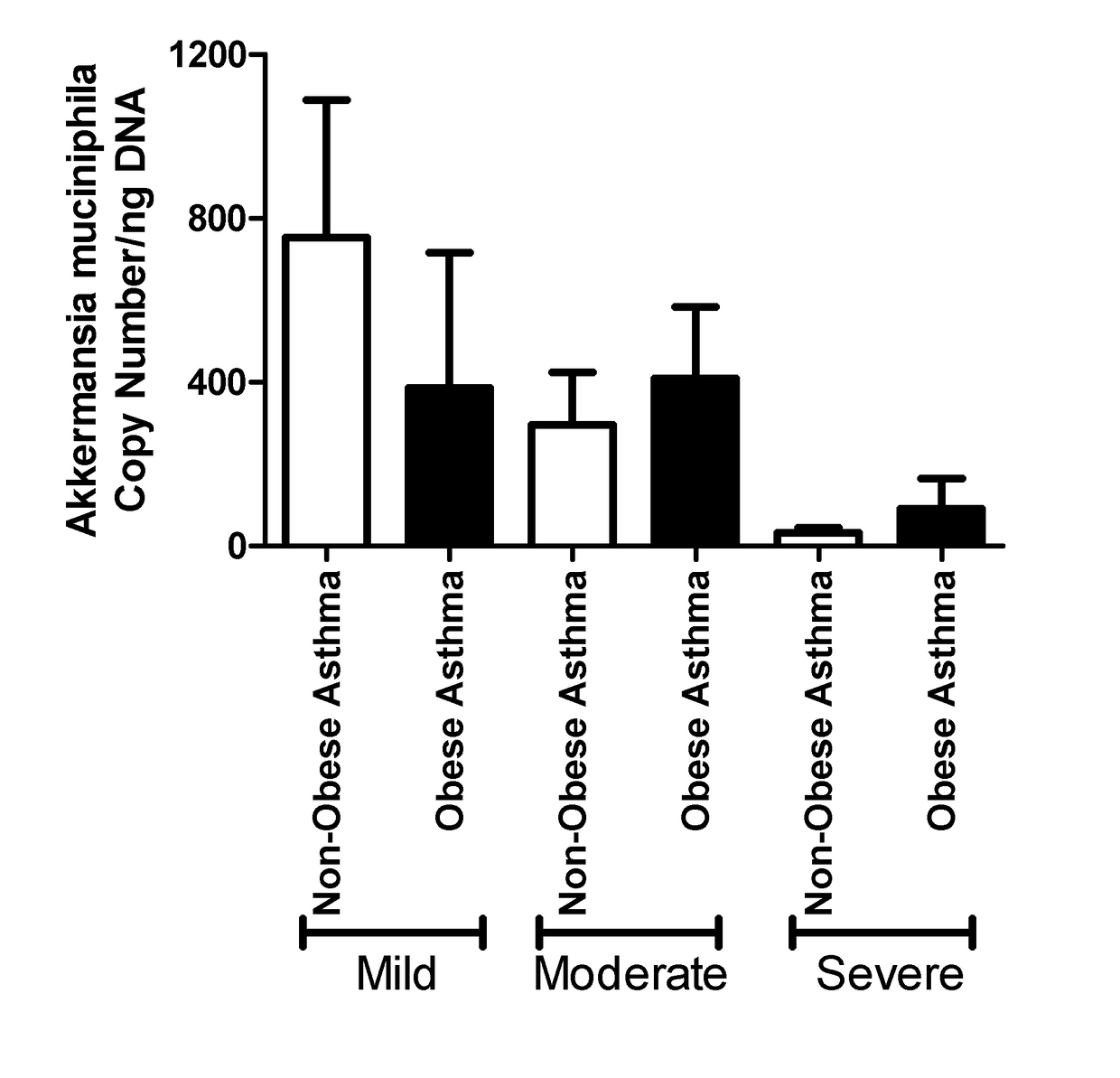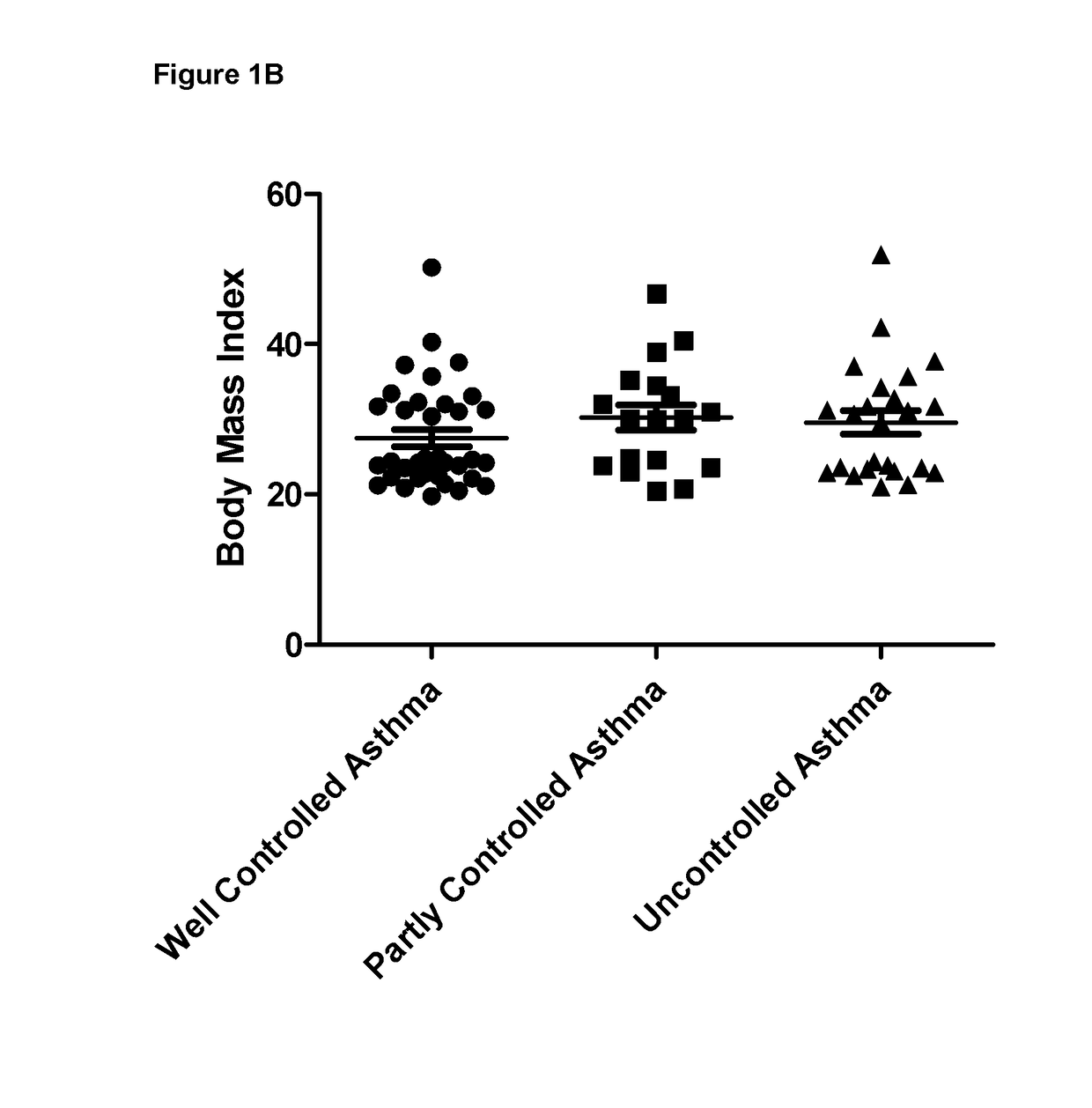Use of akkermansia muciniphila for treating inflammatory conditions
- Summary
- Abstract
- Description
- Claims
- Application Information
AI Technical Summary
Benefits of technology
Problems solved by technology
Method used
Image
Examples
example 1
Abundance of Bacterial Species in Faeces From Asthma Patients
[0059]Freshly voided faecal samples were obtained from asthma patients and were stored at −80 C until analysis. Upon thawing, DNA was extracted from the faecal samples and the 16s rRNA V4 region was amplified by PCR. These PCR products were sequenced using MiSeq and identical sequences were grouped together into operational taxonomic units (OTUs). OTUs were aligned to known 16s sequences and the relative abundance for each OTU was calculated.
[0060]In addition to microbiome analysis, clinical data was collected from all asthma patients. In particular, the level of symptom control was assessed using an internationally validated questionnaire, which asked the following questions.
[0061]Do you experience any of the following?[0062]1. Asthma daytime symptoms more than 2 times per week?[0063]2. Waking at night due to asthma symptoms?[0064]3. Use of rescue medications more than 2 times in the previous week?[0065]4. Exercise or phy...
example 2
Akkermansia muciniphila is Protective in the Murine Models of Asthma
[0069]In order to understand if Akkermansia muciniphila has the potential to directly influence lung inflammatory responses, we performed a murine house dust mite respiratory inflammation study. House dust mite (HDM) allergens are one of the most common aeroallergens that asthma patients are allergic to. Intranasal (i.n.) administration of HDM extract to mice results in lung inflammatory responses. We administered HDM extract i.n. on day 0 (1 μg), followed by higher dose i.n. administrations on days 7, 8, 9, 10 and 11 (10 μg each day). This model is considered to be an acute challenge model. Animals were euthanized on day 14 and bronchoalveolar lavages (BAL) were obtained for enumeration of inflammatory cells. Akkermansia muciniphila (from a stock culture of the inventors) was administered daily (approximately 1×108 cells) by oral gavage, beginning at day −5 until the end of the study. Akkermansia muciniphila was gr...
example 3
Akkermansia muciniphila Induces Immune Regulatory and Anti-Inflammatory Responses in Dendritic Cells
[0078]A further study was carried out with a view to elucidating how the dramatic and unexpected anti-inflammatory lung effect could be induced by a bacterium present within the gastrointestinal tract. Dendritic cells are one of the important cell types within the gut mucosa, which sample luminal bacteria and induce potent polarizing effects on downstream lymphocyte responses (29). Thus we hypothesized that Akkermansia muciniphila stimulated dendritic cells to express high levels of immune regulatory molecules, which would promote the downstream anti-inflammatory effects observed in the lung.
[0079]Human monocyte-derived dendritic cells (MDDCs) were generated by culturing human peripheral blood monocytes in GM-CSF and IL-4 for six days. MDDCs were exposed to Akkermansia muciniphila for 24 hours and ILT4 cell surface expression was measured by flow cytometry, while IL-10 cytokine secret...
PUM
 Login to View More
Login to View More Abstract
Description
Claims
Application Information
 Login to View More
Login to View More - R&D
- Intellectual Property
- Life Sciences
- Materials
- Tech Scout
- Unparalleled Data Quality
- Higher Quality Content
- 60% Fewer Hallucinations
Browse by: Latest US Patents, China's latest patents, Technical Efficacy Thesaurus, Application Domain, Technology Topic, Popular Technical Reports.
© 2025 PatSnap. All rights reserved.Legal|Privacy policy|Modern Slavery Act Transparency Statement|Sitemap|About US| Contact US: help@patsnap.com



